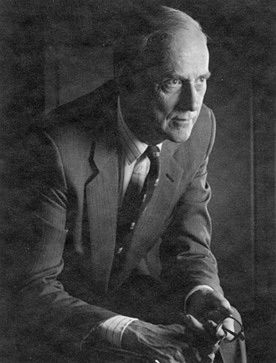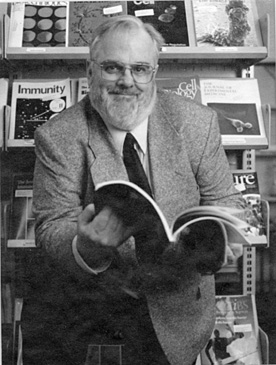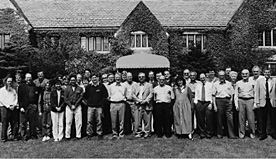The Department of Biochemistry at
the University of Toronto was founded in 1907-08, with Prof. Archibald
Byron Macallum, who was head of the Physiology Department, as its
first chairman. It was the first biochemistry department in Canada
and one of the first in the world. Prof. Macallum is credited with
the organization and extension of the Medical School at Toronto
in the early 1900’s and he was a strong advocate for the construction
(1902-1904) of the original Medical Building, on the third floor
of which the Department of Biochemistry was housed for 60 years.
Macallum’s research was influential in its time. He contributed
to the knowledge of the localization of calcium, potassium and iron
in plant and animal tissues by microchemical tests, and his comparisons
of absolute and relative concentrations of the inorganic elements
in sea-water and in the body fluids of many animals supported the
concept of the origin of land animals from the sea. He received
the unusual honour, for a Canadian, of election to Fellowship in
the Royal Society of London. He was part of a small group who organized
the American Society of Biological Chemists, was active on the executive
of the Society and served as its president from 1911 to 1913 at
the time when the Federation of American Societies of Experimental
Biology was created.
Between 1919 and 1951, the Department
had only two chairmen, Andrew Hunter (1919-1929) and Hardolph Wasteneys
who had joined the Department in 1917. A Department of Zymology,
formed in 1919 under Prof. Horace Speakman, merged with the Biochemistry
Department in 1929.
In Andrew Hunter’s time, biochemistry was mainly the servant
of clinical medicine, with emphasis on chemical analysis of tissues,
urine and blood in health and disease. His monograph on creatine
and creatinine was a definitive work before the discovery of phosphocreatine.
Wasteneys (1929-1951) was interested
in the synthesis of protein, before the days of tRNA, mRNA or ribosomes.
His main collaborator in the field was Henry Borsook who worked
with him during the 1920’s. They investigated conditions that
would reverse the proteolytic action of pepsin.
During the 1930’s, Wasteneys brought a succession of professors
from the U.K. for short terms. Among these was Guy Marrian whose
work with his graduate students on the isolation and structure of
estrogenic hormones received world-wide recognition. During World
War II, many members of the Department were engaged in secret projects
for the Department of National Defence, including work on BAL (British
Anti-Lewisite), an antidote to mustard gas. In connection with the
war effort, radioactive sulphur was used in the Department in 1941;
these experiments were one of the earliest applications of the radioisotope
technique that became a major tool in biochemical research.
Because of the depression of the 1930’s
and the war years, the Department grew very slowly and in 1950 there
were only 5 professors on the staff. Nevertheless, by this time
75 Masters degrees and 59 Ph.D. degrees had been awarded and many
of the graduates went on to professorial positions in the biochemistry
departments and life science departments that were being established
throughout Canada, the United States, and other countries. One of
the earliest Ph.D. students in the Department of Zymology was Arthur
Wynne who became a professor in Biochemistry upon the merger of
Zymology with Biochemistry in 1929 and remained in the Department
until his retirement in 1960, serving as Chair from 1951 to 1960.
In 1958 he was elected as the first president of the Canadian Biochemical
Society, which had been formed as a result of the deliberations
of an unofficial committee chaired by Gordon Butler, at that time
a professor of Biochemistry at Toronto.
Jeanne Manery Fisher was the first
woman to achieve professorial status in the Department. In 1932
she graduated from the Biological and Medical Sciences course given
by the Department of Biochemistry at the University of Toronto and
after obtaining her Ph.D. in Physiology, and post graduate studies
in the United States, she returned to the Department in Toronto
in 1940. Although she carried heavy teaching responsibilities and
established an active research program, prejudices against women
academics prevailed and she was not appointed to the professorial
staff until 1948. She maintained her research program until her
death in 1986, and achieved world wide recognition for her studies
on electrolytes, during the development of this field from doubts
about the reality of a true plasma membrane to the isolation from
the membrane of the key molecule involved in transporting Na+ and
K+ across cell walls. Very aware of the need to increase the visibility
and participation of women in the Canadian Biochemical Society,
she was instrumental in establishing its Equal Opportunities Committee
in 1981. Following her death, the Society established the Jeanne
Manery Fisher Lecturer Award to honour her memory.
Gordon Butler was a professor in the
Department for 12 years (1947-1959) and with his 19 graduate students
initiated and carried out a ground-breaking research program on
what was then known as thymus nucleic acid. According to TIBS (4,
June, N124) their contributions included introduction of the light-scattering
method for measuring the molecular weights of DNA molecules; introduction
of the ‘SDS method’ as a general procedure for preparing
DNA; introduction of a method for effecting a quantitative conversion
of DNA to its constituent 5’-deoxyribonucleotides; discovery
that there are enzymes that can degrade DNA by an ‘exo’
action at the termini of polynucleotide chains; definitive characterization
of 2-deoxy-D-ribose as the sole sugar component of DNA; and introduction
of the gel-electrophoresis approach for separating nucleate-associated
proteins.
Charles Hanes joined the Department
in 1951 and chaired it from 1960 to 1965. During his term, money
became available to add 9 new professors to the core staff and to
appoint 3 part-time tutors for the laboratory classes. He was responsible
for introducing the procedure of appointing the Departmental chairman
for a 5 year term (renewable once) instead of the chairmanship being
a “life sentence”.
Before coming to the Department, Hanes
had become well known for his discovery and initial characterization
of plant phosphorylases and had been involved in the development
of paper chromatography for the separation of phosphoric esters.
In Toronto, he refined this technique and applied it to the separation
of amino acids and peptides. In his laboratory, diverse products
of transpeptidation were characterized and quantitated, kinetic
studies were carried out of sucrose phosphorylase and alcohol dehydrogenase,
and elastase was used to investigate the structure of elastin. Hanes’
first two graduate students in Toronto were George Connell and Gordon
Dixon, both of whom produced Ph.D. theses on transpeptidation reactions,
later joined the professorial staff of the Department, and then
went on to more and more illustrious achievements. When they were
in the Department, their research on the chemistry of haptoglobulins
and immunoglobulins led to the development (with Oliver Smithies)
of the technique of starch gel electrophoresis which was widely
used for many years.
In addition to his research program
on the structure and function of antibodies and enzymes, George
Connell chaired the Department from 1965 to 1970, held major administrative
positions at the University of Toronto, was president of the University
of Western Ontario from 1977 to 1983, and president of the University
of Toronto from 1984 to 1990. Upon his retirement, generous donations
were made to establish a lectureship in his name to support a visiting
lecturer each month.
The 1960’s were good years,
with funding for a new Medical Sciences Building, completed in 1968,
new equipment, and new staff. As the members of the Department moved
into the fifth floor of the new building, there were few regrets
to leaving behind the cockroaches, mice, mercury in the cracks between
the floor boards from the van Slyke equipment, inadequate cold rooms,
and lack of air conditioning. Space was also available for the members
of the core Department who had had laboratories in a building on
Spadina Avenue. The professorial staff was expanded by introducing
the practices of giving cross-appointments to members of other departments
such as the Banting and Best Department of Medical Research, and
of making honorary appointments of some members of the research
institutes, particularly at the Hospital for Sick Children. As a
result, the graduate student population increased enormously, to
70 students in 1970. Fearing that there would not be positions for
the anticipated large numbers of new biochemists since the graduate
student population at other Canadian universities was also expanding,
the graduate students persuaded the department to limit each professor
to no more than 2 graduate students at any one time (previously,
5 or 6 had been the norm). However, this restriction lasted for
only a few years.
In the early 1970’s, undergraduate
instruction in biochemistry for Arts and Science students was greatly
increased to include students in disciplines other than biochemistry,
as well as larger numbers of biochemistry specialist students. The
Department continued its teaching responsibilities for medical students,
and took major roles in a new ‘systems’ curriculum introduced
at this time.
G. Ronald Williams chaired the Department
from 1970 to 1977 and later continued the involvement of Toronto
biochemists in major administrative roles as Principal of Scarborough
College. During his chairmanship, research blossomed and on 3 occasions,
members of the Department received Canadian Biochemical Society
Ayerst (Merck-Frosst) awards. In response to the student unrest
of the 1960’s, a Departmental Constitution was written, a
Departmental Council with broad representation was established,
and a graduate student organization was set up to co-ordinate graduate
student activities in the Department. This Biochemistry Graduate
Students Union (BGSU) is very active to-day, coordinating the student
seminars and organizing social events.
In the 1970’s, there were 27
appointments to the professorial staff, 8 of these to the core Department,
but during Keith Dorrington’s chairmanship (1977-1982) repeated
cuts of the Departmental budget almost eliminated new appointments
to the core. Dorrington’s work after joining the Department
in 1970 focussed on the structure and function of immunoglobulins
and resulted in an Ayerst award in 1977. He was another biochemist
with administrative talents and served as Vice Provost, Health Sciences
and Associate Dean, Basic Sciences, in the Faculty of Medicine.
In July of 1979, the XIth International
Congress of Biochemistry was held in Toronto with 7500 scientists
in attendance. The 75th anniversary of the founding of the Department
was held in 1983 during Marian Packham’s term as Acting Chair.
The activities included a symposium, an Open House, and a banquet
in Hart House at which Dr. Thomas Jukes (Ph.D. 1933) was the keynote
speaker. The 320 registrants, many of them former students, came
from across Canada and the United States.
Harry Schachter became chair in 1984
for a 5-year term. He had been Gordon Dixon’s first graduate
student in Toronto and had been immediately appointed to the core
professorial staff upon completion of his Ph.D. in 1964. Well before
becoming chair he had gained international recognition for his studies
of the complex structures of the oligosaccharides of glycoproteins.
As an emeritus professor of Biochemistry, he continues his active
research program at the Hospital for Sick Children where he moved
in 1976 and, for a number of years, chaired the Division of Biochemical
Research.
A recurring theme in the Department’s
history is the choice of members from our core for major administrative
roles elsewhere in the University; some of these have been mentioned
earlier. In 1989, for example, George Connell was President of the
University, G. Ronald Williams was Principal of Scarborough College,
Robert Painter was Provost and Vice Chancellor of Trinity College,
and Anders Bennick was Chairman of the Graduate Department of Dentistry.
From 1989 to 1991, search committees
were repeatedly unsuccessful in attracting a chair from outside
the University of Toronto while William Thompson served capably
as Acting Chair. During this time, the Protein Engineering Network
of Centres of Excellence (PENCE) was set up and Toronto became one
of the four academic centres participating in it. Professors Emil
Pai and Harry Schachter became co-leaders with 9 professors in Biochemistry
participating. A protein crystallography centre was established
in the Department, also under the direction of Emil Pai.
In 1991, Peter Lewis, who had joined
the Department in 1974, was chosen as Chair. He served two terms,
during which major changes were made in staff and in the focus of
the research being carried out. The hiring frenzy of the 1960’s
inevitably resulted in a large number of retirements in the 1990’s
– 9 professors from the core department and 5 status-only
and cross-appointed professors. Despite base budget cuts, the department
was able to recruit 8 core department primary appointees and 9 status
only or cross-appointed members, bringing the present total to 55,
with 20 of these based on the campus. Credit for this renewal into
a vigorous and youthful department belongs to Peter Lewis who was
exceptionally active in finding opportunities for growth and arranging
joint appointments with sister departments. In 1993, the installation
of a 600MHZ NMR instrument in the Medical Sciences Building facilitated
the research of newly recruited Julie Forman-Kay and Lewis Kay.
Faculty “Retreats” in 1993 and 1998 ensured that all
members of the Department participated in planning. Decisions made
during this time resulted in at least half of the departmental members
focusing their research activities on proteins, including structure
determination, dynamics, in vitro and in vivo folding, proteomics,
and structure-function studies. A highly-rated Collaborative Program
in Biomolecular Structure has been set up involving 25 investigators
from four departments. This program is designed to provide a stimulating
training environment for Ph.D. students and serve as a forum to
foster interactions among the participating research groups. The
three focus groups are Protein Crystallography, NMR, and Protein
Folding.
In 1998, a new multidepartmental program
in Proteomics and Bioinformatics (P&B), with Peter Lewis as
director, was initiated. Some of the new members of the Department
of Biochemistry were hired through this program.
The present Chair, Reinhart Reithmeier,
began his term in July of 2002, taking over a Department filled
with enthusiastic, award-winning researchers and teachers. Instruction
is provided for the education of students in the Faculties of Medicine,
Arts and Science and the School of Graduate Studies. The annual
enrolment in all these courses exceeds 1800 students. Biochemistry
courses for undergraduate students in the Life Sciences are offered
during the second, third and fourth years; courses on special topics
are available to graduate students.
The Department is geographically diverse
with faculty based in the Medical Sciences Building, the Research
Institute at the Hospital for Sick Children, the Banting and Best
Department of Medical Research, and several other sites, including
the University of Toronto at Mississauga and at Scarborough.
Many members of the Department have
received prestigious awards for their research. Fifteen of them
were or are Fellows of the Royal Society of Canada. Among them is
David MacLennan of the Banting and Best Department of Medical Research
who has been an active cross-appointed member of the Department
since 1980; his long list of prizes includes appointment in 2002
as an Officer of the Order of Canada for the investigations in his
laboratory of how normal sarcoplasmic reticulum proteins carry out
their functions of calcium transport, sequestration and release
and how mutant forms cause abnormalities or disease.
It remains for later historians to document the impressive achievements
that our younger members are in the midst of accomplishing. As we
approach our 100th anniversary, we look forward to an even greater
future for the Department of Biochemistry in the Faculty of Medicine
at the University of Toronto
|
|

Archibald Byron Macallum
First Chair of Biochemistry
1907-17


Hardolph Wasteneys
Chair 1929 - 1951
 
Jeanne Manery Fisher

 Charles
Hanes Charles
Hanes
Chair 1960 - 1965

 George
Connell George
Connell
Chair 1965-70, U. of T. President
1984-90

 Original
Medical Building Original
Medical Building


New Medical Sciences Building
1968


Faculty and Staff 1976
click
here for larger image



 Peter
Lewis Peter
Lewis
Chair 1991-2001, Vice Dean Research
2002-

 Carol
Justice Carol
Justice
Business Officer 2006
Admin. Assistant - Finance 1966 - 2006 (with a break here and there!)


Faculty
and Staff 1998
click here
for larger image
|





















